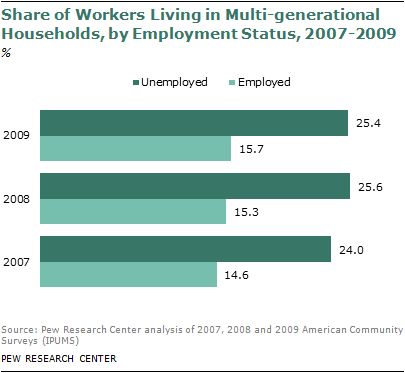The number of Americans living in multi-generational households rose sharply during the Great Recession. From 2007 to 2009, the population living in these households increased by 4.9 million. By contrast, the number of people in other households rose by 333,000 and the population in group quarters or of unidentified generation increased by only 156,000.9
The increase in adult children (ages 25 and older) living in their parents’ homes was a driving force boosting the number of multi-generational households. The number of households in which a child age 25 or older lived with a parent increased 590,000 from 2007 to 2009. That was a marked change of pattern from recent years—from 1990 to 2006, the number of these households did not significantly change.

Moving in with family can make economic sense. For some groups, the incomes of multi-generational households are higher than the incomes of other households. Living together may also reduce poverty—in 2009, the poverty rate among residents of multi-generational households was 11.5%, compared with 14.6% for those in other households. The potential benefits are even greater for the most economically vulnerable—unemployed workers, young adults, Hispanics and blacks.
The economic benefits of living in multi-generational households flow from the addition of earners to the household. The resulting increase in household income is often more than enough to compensate for the increase in household size. Shared living arrangements also can reduce the burden on any single member for supporting the household. This may help people in multi-generational households navigate through economic storms.
The rapid increase in multi-generational living arrangements during the Great Recession is associated with a spike in unemployment. The unemployed are much more likely than the employed to live in multi-generational households—25.4% vs. 15.7% in 2009. This differential did not change much during the recession, but the number of unemployed people did, increasing by 7.2 million from 2007 to 2009.10
Also, the resources of the unemployed were likely stretched more than usual in a recession that set a record for the duration of unemployment since these data first became available in 1967. When the recession started in December 2007, the median duration of unemployment was 8.4 weeks. By the end, in June 2009, the median duration was 17.4 weeks. The typical length of an unemployment spell continued to rise thereafter, peaking at 25.5 weeks in June 2010.11
Other than the unemployed, young adults ages 25 to 34, Hispanics, blacks and immigrants realize notable economic benefits from multi-generational living arrangements. These groups also registered among the greatest increases in those types of households from 2007 to 2009. Although household heads retain the principal burden of providing income in multi-generational households, adult children and parents of householders also account for significant shares of the income of these households.




